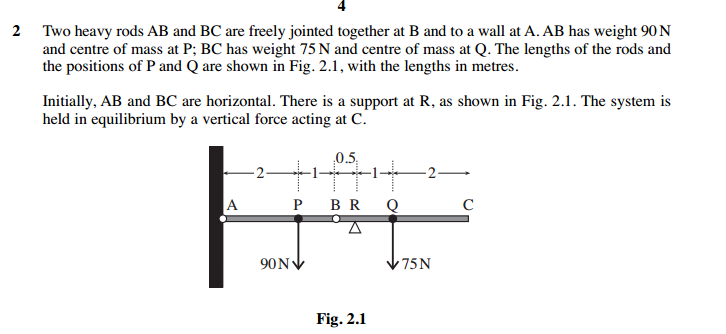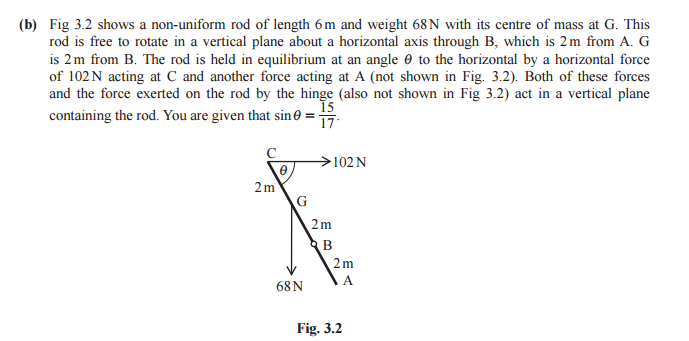Quick M2 question
So in this question, two rods are connected by a hinge at B by there is no Y or X force. But the hinge at A does.

However, this question:


There is a Y and X force at the hinge at B. I thought two rods connected to each other with a hinge, have net 0 resultant force because they both cancel each other out and act as internal forces?

However, this question:


There is a Y and X force at the hinge at B. I thought two rods connected to each other with a hinge, have net 0 resultant force because they both cancel each other out and act as internal forces?
Original post by Bealzibub
So in this question, two rods are connected by a hinge at B by there is no Y or X force. But the hinge at A does.

However, this question:


There is a Y and X force at the hinge at B. I thought two rods connected to each other with a hinge, have net 0 resultant force because they both cancel each other out and act as internal forces?

However, this question:


There is a Y and X force at the hinge at B. I thought two rods connected to each other with a hinge, have net 0 resultant force because they both cancel each other out and act as internal forces?
I may be interpreting the latter system incorrectly*, but the fact that it refers to AC as "the rod" seems to suggest that the points A, B and C must remain collinear throughout the motion i.e. the two sections AB and BC are not free to rotate independently of one another via the hinge (as is the case in the first system you mention, in which the two sections are connected only by the hinge and are independent otherwise). Instead, the entire rod rigidly rotates about B and therefore a force is exerted by the entire rod on the hinge at B.
*The only reason I am unsure is because the question chose to use the word "hinge" as opposed to "pivot". I'm more than prepared to be corrected!
Quick Reply
Related discussions
- Help in statistics please
- A Level Maths Stats
- the issac physics astronomy question
- What units do I need for Edexcel IAL or IAS Further Maths
- Further Maths 2023/2024!!!
- Partial derivatives and small changes
- Further Maths! M1 and M2
- Isaac Physics Essential Pre-Uni Physics C2.5 part E
- Edexcel IAL Maths & Further Mathematics
- Grade Growth Chronicles | From C's to A's (23-24)
- a level physics- Engineering option question (1)
- A level chemistry help please
- Stationary Points 5
- GCSE results
- Deciding Edexcel IAL FM Cash-in Unit Combinations
- Revising for Edexcel's AS Maths - running out of material.
- Are these GCSEs good enough for these unis?
- How Hard is A Level Further Maths?
- bookw0rmm's Laptop recommendation thread
- Buying Macbook for University
Latest
Last reply 1 minute ago
Official Dental Hygiene and Therapy (Oral Health Science) 2024 Entry ThreadDentistry
2860
Last reply 1 minute ago
Official UCL Offer Holders Thread for 2024 entryLast reply 2 minutes ago
IDEA silver award entrepreneur resilienceLast reply 2 minutes ago
Official London School of Economics and Political Science 2024 Applicant ThreadLast reply 3 minutes ago
Haven't heard back from LSELast reply 3 minutes ago
November 2023 Illegal Migration Intake Unit - Intake Response Team - Immigration OffiLast reply 4 minutes ago
Amazon Apprenticeships 2024Last reply 5 minutes ago
My boyfriend doesn't believe in forever and he said that he can't love me "forever"Last reply 7 minutes ago
PA Consulting Degree Apprenticeships 2024Last reply 8 minutes ago
Official Cambridge Postgraduate Applicants 2024 ThreadLast reply 9 minutes ago
Physiotherapy (B160) - Ulster UniversityLast reply 9 minutes ago
HSBC Degree Apprenticeship 2024Last reply 10 minutes ago
Interview at the University CumbriaLast reply 10 minutes ago
Goldmansachs Degree Apprenticeship 2024Posted 11 minutes ago
Seeking Advice on Pursuing Psychology Conversion Course and Further StudiesLast reply 11 minutes ago
aqa a-level english language cla - only learn one?Last reply 12 minutes ago
LSE anthropology and law 2024Last reply 13 minutes ago
Schroders apprenticeship 2024Last reply 13 minutes ago
DWP EO Job Centre Work Coach - March 2024Trending
Last reply 1 week ago
Edexcel A Level Mathematics Paper 2 unofficial mark scheme correct me if wrongMaths
71
Trending
Last reply 1 week ago
Edexcel A Level Mathematics Paper 2 unofficial mark scheme correct me if wrongMaths
71




